Relieving the winter doldrums
Austin has so many mild winter days that it’s really a shame not to be out enjoying your garden at this time of year. But what if your flowery perennial garden dies back in winter and you’re left with brown grass, leaf-strewn beds, and a shade tree or two? What can you do to enliven your winter garden besides plant tried-and-true boxwood, dwarf yaupon holly, and nandina?
Go spiky. Get yourself some yuccas, hardy agaves, and prickly pear. These sculptural plants can be colorful like this ‘Bright Edge’ yucca or serenely gray or blue-green. Cool weather can heighten the coloration of certain succulents, especially striped yuccas, soap aloe, and purple prickly pear, as well as non-hardy succulents like ‘Sticks on Fire’ euphorbia, which must be protected from freezes.
‘Whale’s Tongue’ agave (Agave ovatifolia)
But the main draw is their architectural form, which commands attention all winter when the perennials have died back. Don’t be afraid of the spikes. Get some.
Go feathery. Try out some hardy bamboos and ornamental grasses, which will add fine texture and movement to your garden all year. I really love the loose, feathery form of Mexican weeping bamboo (Otatea acuminata aztecorum), a clumping bamboo that is marginally hardy for Austin. Give it some protection from northern winds, and plant in spring so it can get established before winter, and it should do fine. I also like ‘Alphonse Karr’ bamboo, a variegated variety with yellow stripes. Just be careful not to choose a running bamboo unless you want to battle its incursions for eternity and suffer your neighbors’ wrath when it invades their yards.
For more feathery texture, don’t overlook non-evergreen grasses, like ‘Adagio’ miscanthus, which blooms in fall with curling inflorescences that, by winter, resemble toasty brown waves tossed on a stormy sea. Plant them against a silvery evergreen like Arizona cypress (the blue-green tree in the middle) for contrast. I backed up this vignette with the chartreuse green of another ornamental grass, bamboo muhly (Muhlenbergia dumosa). That’s wonderful color and texture that lasts all winter—and all summer for that matter. Just cut the miscanthus to the ground in mid-February (not now, as I see in commercial plantings all over town), and watch the cycle begin again.
Add evergreen groundcovers. This is trickier, but there are some beautiful groundcovers that remain all winter in Austin, like Australian strawflower (Chrysocephalum apiculatum ‘Flambe Yellow’), which even continues to bloom.
‘Sparkler’ sedge, at middle left, adds evergreen-and-white stripes to the shade garden. ‘Toffee Twist’ sedge, at bottom right, isn’t green but provides wiry coppery texture, punctuated here by white-blooming ‘Diamond Frost’ euphorbia that will likely succumb to next week’s predicted hard freezes. In the pot is native Texas nolina, a super-tough plant for sun or shade. It makes a meadowy groundcover and looks equally fabulous cascading from a pot. And don’t forget ‘Bath’s Pink’ dianthus for sun, lamb’s ear for dry shade, and our native heartleaf skullcap (Scutellaria ovata ssp. bracteata) for sun or part-sun, which returns from summer dormancy at this time of year and whose fuzzy blue-green leaves always elicit comments from visitors.
Add a water feature. A bubbling fountain makes a focal point in all seasons, as does a still pond like this one. True, many of the pond plants die back in winter, but the mirrored surface of the water is always magical.
A few pond plants are still hanging on, even after several light freezes.
Add containers to your garden. If you plant hardy evergreens in some of your pots, and choose freeze-resistant glazed pots from Vietnam, you won’t have to put them all away in the winter. Potted plants add so much winter interest to the patio, but they also work magic tucked into garden beds, where their height helps them fill in holes and add focal points. Glazed pots go one step further in winter by adding much-needed color. I tend to plant my containers with hardy succulents or drought-tolerant grasses so that I don’t need to water every day in summer; in winter they may not need to be watered at all, or only very rarely.
Closer to the house my containers may hold a mixture of hardy succulents, like the golden barrel cactus and the artichoke agave (Agave parryi var. truncata), and tender succulents; I’ll cover these when a hard freeze is predicted, but they weather light freezes just fine under the cover of a spreading live oak and protected from the north wind by the house.
I didn’t even mention colorful furniture, arbors and other structures, and garden art as ways to give winter interest to the garden. Try adding some of these to your central Texas garden and see how they make a difference in your enjoyment of your garden in the so-called off-season.
All material © 2006-2011 by Pam Penick for Digging. Unauthorized reproduction prohibited.


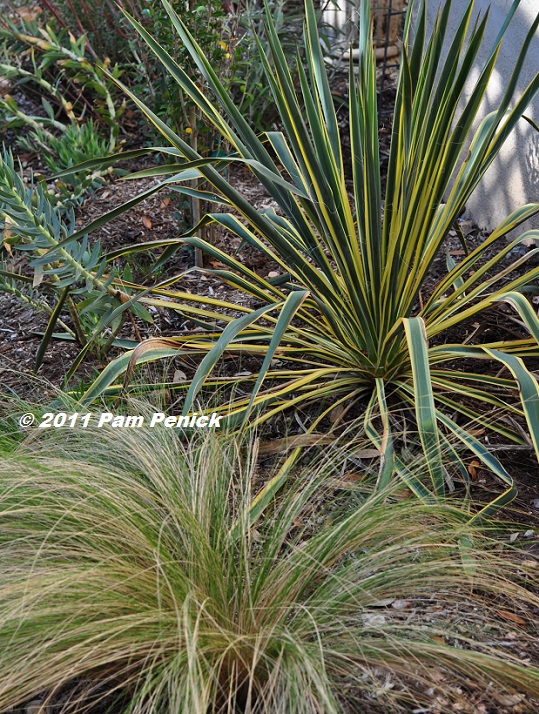
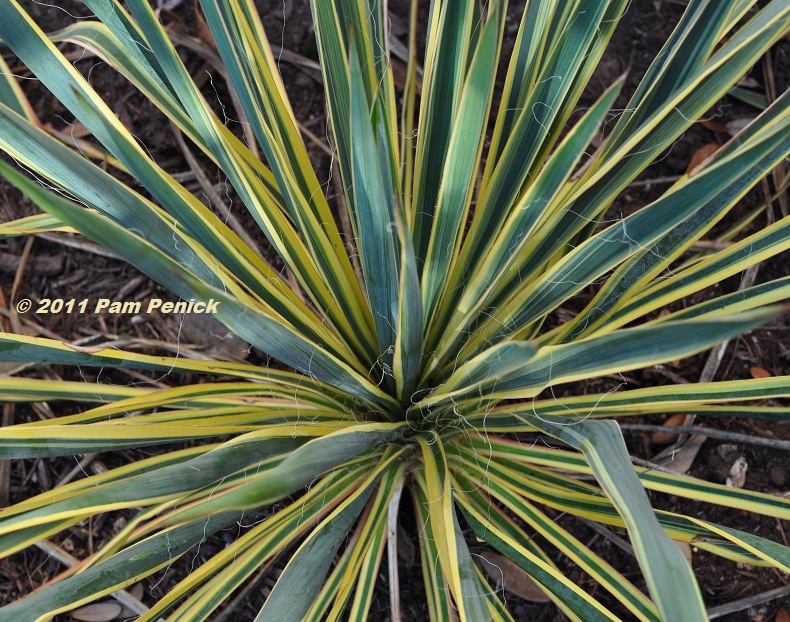
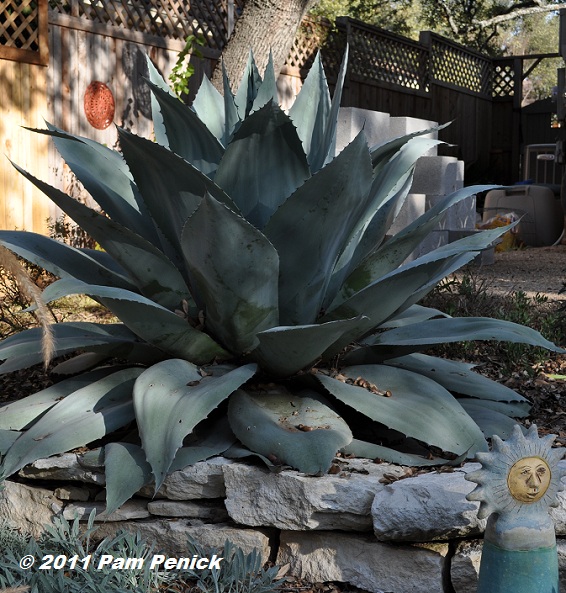
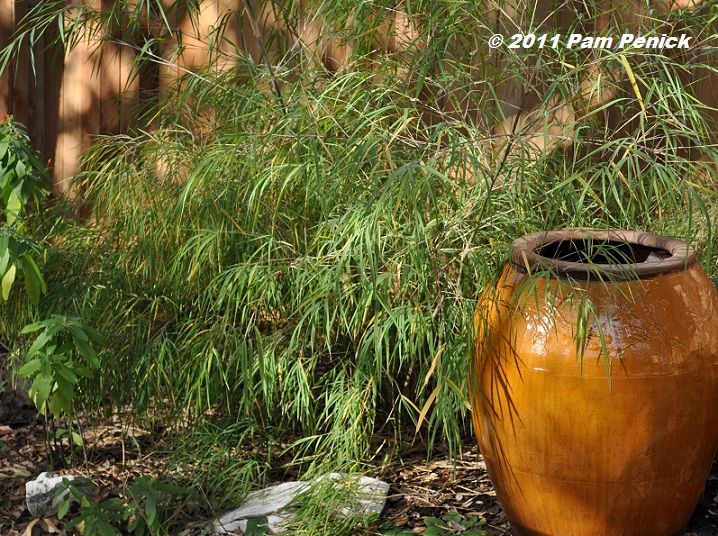
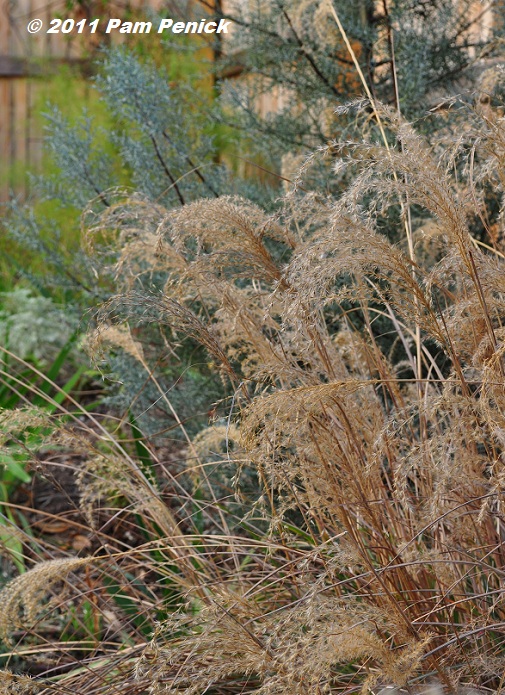
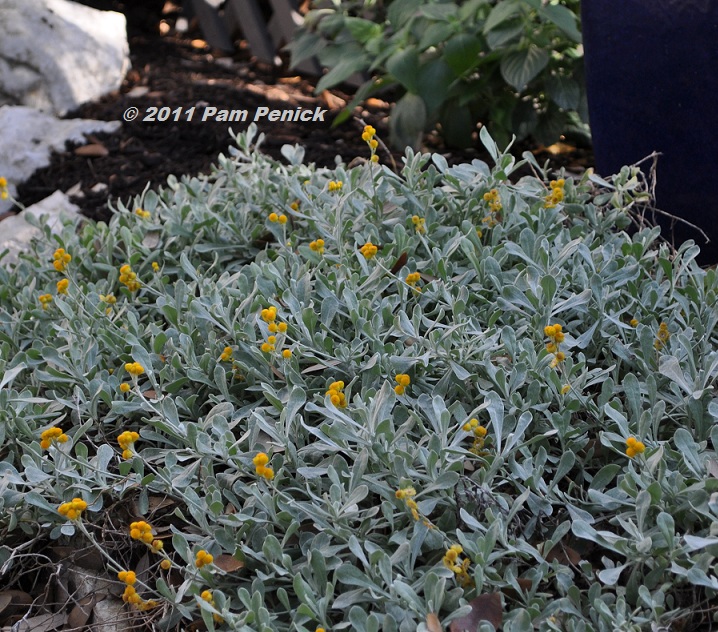
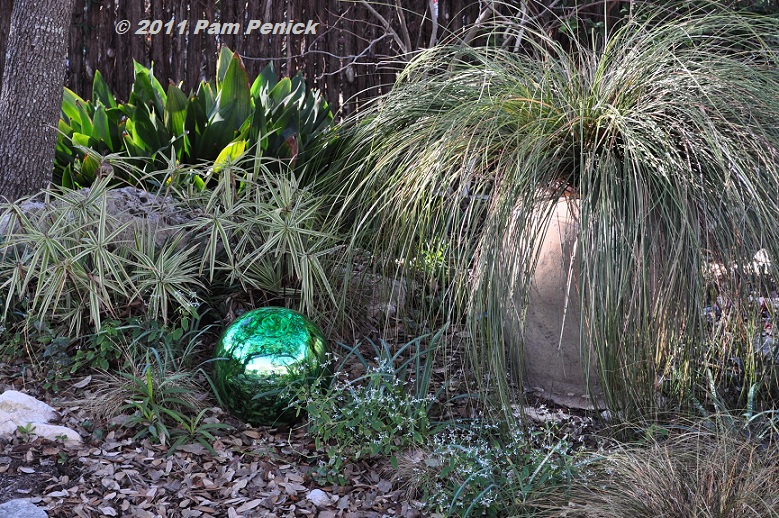
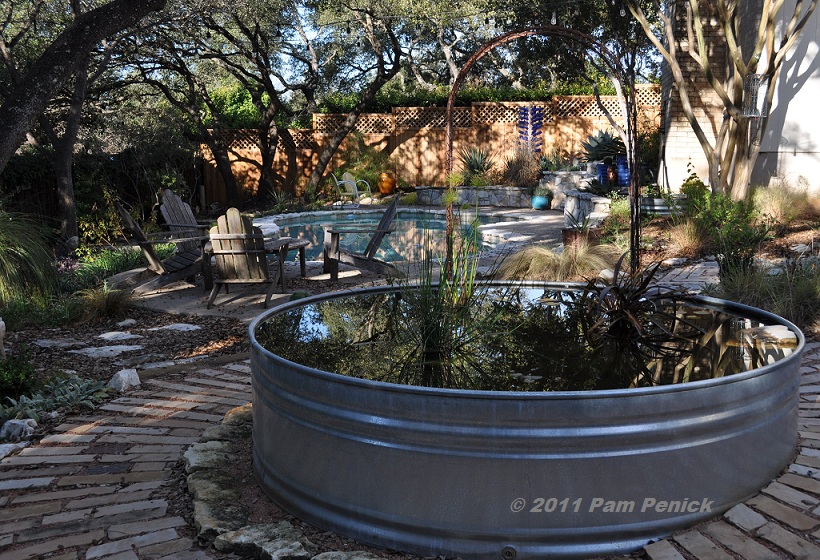
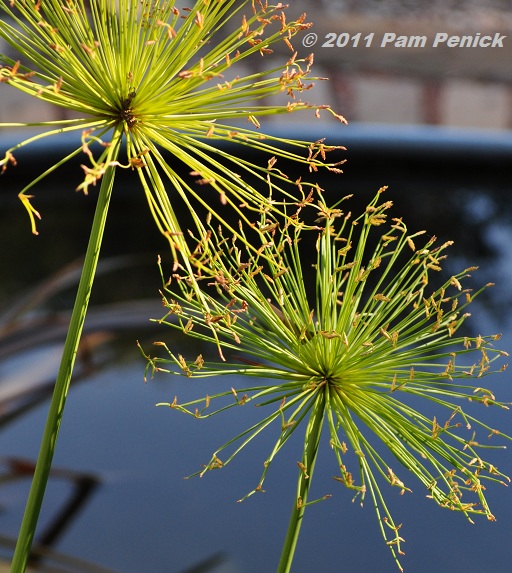
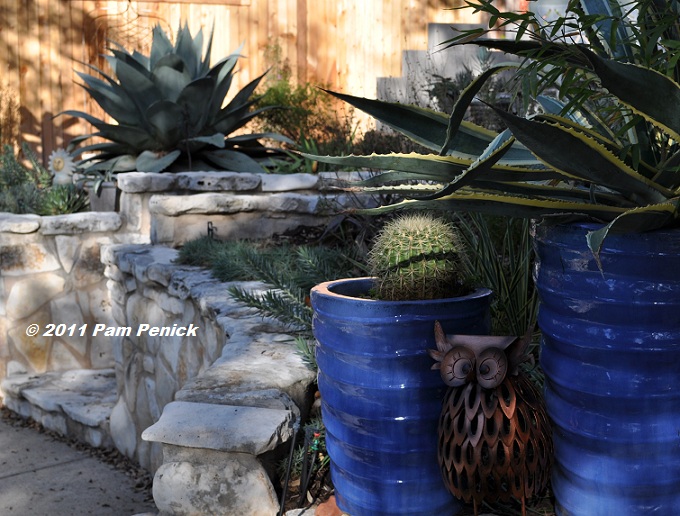
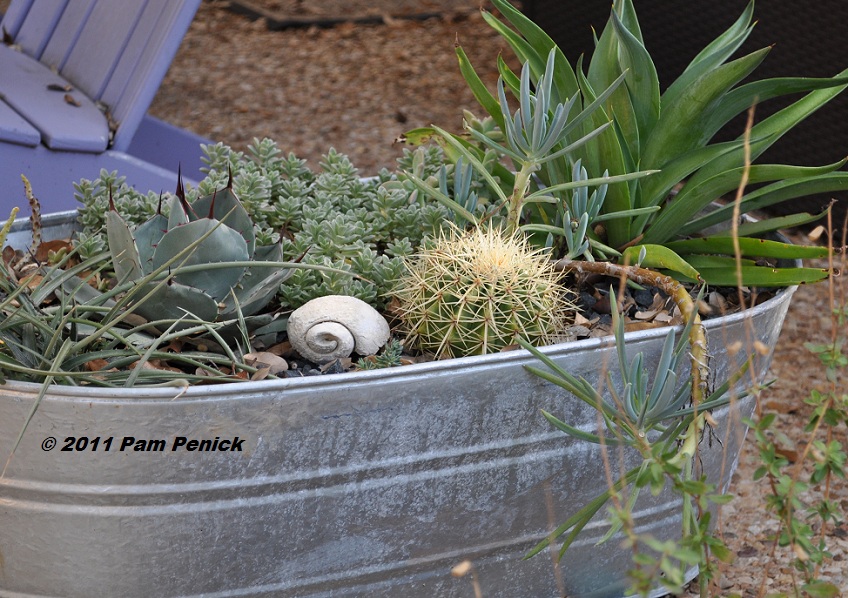
There are great shapes in here – I wish I could grow a garden full of agaves – very pretty
Okay, I have added more to my wishlist. I like your combination of tender and hardy succulents. Thank goodness for succulent container plants that don’t have to be watered every single day! I love your circle path around the pond.
Great suggestions here Pam. I just read that you can propagate Diamond Frost by taking cuttings and rooting in water. I know it has a patent, if it’s for your own use would that be so bad? The one I was over wintering on the front porch was all but dead when I got my greenhouse for Christmas, now it’s greening up, just cut the dead out of it today.
Great post Pam, and of course I love your urging people to “go spiky”…your garden is looking fabulous! I can’t believe you still have papyrus growing.
You have a great selection of plant form, texture and interest. I love seeing gardens with such variation. It adds a lot of pizazz.
I wanted to let you know your post was so beautiful that it is featured on WebGarden today. Our readers enjoy getting ideas and inspiration. I hope many will follow your blog after visiting.
Thanks for sharing your gardening talents! ~Brooke (CreativeCountryMom)
http://creativecountrymom.blogspot.com/
Here is the link to see your post….
http://www.facebook.com/pages/WebGarden/261885457648?ref=ts
Thank you, Brooke! I appreciate the link! —Pam
Nice…looks like winter has barely, at most, even touched your garden. Here, it has a vice grip on us…what’s the deal with that, esp. for 5 years straight? Arrgh…enjoy your garden for me.
Oooh, Australian strawflower. Another plant to explore from your garden. Deer resistant?
I don’t know, Kathleen. This one is growing in the fenced back garden. I’ll have to try it out front next year. —Pam
Great suggestions. I wouldn’t be without my bamboos and grasses, though my wonderful Phormium eventually outgrew its patch and has been divided and spread around out the front to give year-round interest to the bits of my garden I tend to neglect.
Wow – what a great posts and so smartly organized! That whale’s tongue agave is amazing – how true it’s name is! I have some bamboo in my backyard and I love how it stays green all year round and sways with every breeze. It’s snowing right now and the snow looks so pretty on it’s leaves.
i love seeing gardens in “off” season. you can see their inner structure better, as well as the garden accents. it’s even interesting to watch and see how plants hold on, adapt and endure during stressful conditions.
GREAT post. I was just thinking my yard looks so dreary. I’m going to spend some allowance on a bright pot asap! Ta da!